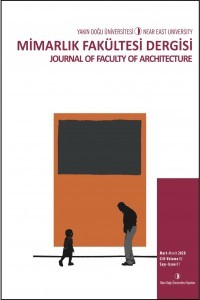Tekerleği Yeniden İcat Etmek: Alt Gelir Grubu Konut Mimarisi
Mimarlık pratiğinde endüstrileşme ile çok büyük bir problem haline gelen büyük kent çeperindeki çoğu illegal yerleşim alanları tüm dünyada bu alanları oluşturan alt gelir grupları için yeni tasarım yöntemleri geliştirilmesine neden olmuştur. Bu çalışmaların önemli örneklerinin son yıllarda özellikle Latin amerika ülkelerinde uygulama alanı bulması dikkat çekicidir. Çalışmanın amacı çok erken bir tarihte alt gelir grubu için ilk örnekleri oluşturam mimar Behçet Sabri nin bu ilk çalışmalarından hareketle bugün halen çok büyük bir sorun olarak devam eden alt gelir grubu konut sorununa örnek olabilecek tasarım yöntemlerini tartışmaya açmak, tarihsel süreçte gelişen tasarım yöntemlerinin geldiği nokta üzerinden sorunu yeniden ortaya koymaktır. Son yıllarda alt gelir grupları için yapılan onca özverili çalışma ve yatırıma karşın sorun en azından tasarım alanında katmanlaşarak devam etmektedir. Bu amaçla yazılı kaynak taraması ile, tasarım yöntemlerinin tarihsel gelişiminden hareketle, alt gelir grubu konut uygulamalarını okumak, önemli tasarım kavramları ile inceleyerek, karşılaştırılıp değerlendirmek çalışmanın yöntemini oluşturur. Toplumsal yaşam içinde önümüzde duran oluşumları okunur, anlaşılır hale getirmek ve elde edilen bilgi üzerinden yeni karar mekanizmalarına yol göstermek önemlidir. Hızla gelişen kent lekelerinde, en büyük alanı kaplayan alt gelir grubu konut bölgeleri hazır bitmiş konut sunumlarının istenen çözümlere bizi ulaştırmadığını, aksine problemin çok farklı boyutlarda gelişerek, çözüm beklediğini göstermiştir. Esnek, değişip dönüşebilen, kullanıcıların tasarıma katılabildiği ve gelecekteki ihtiyaçları çözümleyebilen tasarımlar, hergün daha da karmaşıklaşan alt gelir grubu konut sorununun çözümlenebileceğine dair fikir ve umut vermektedir
Anahtar Kelimeler:
alt gelir grubu, konut tasarımı, konutta dönüşebilirlik
Reinventing the Wheel: Lower Income Group Housing Architecture
As a result of global indusrialisation a growing number of illegal settlements, usually at the fringes of large cities, has led to the development of new design methods and strategies for lower income housing. It is noteworthy that important examples of these strategies have found application in recent years, especially in Latin American countries. The aim of this study is to analyse the first examples of low income housing by the architect Behçet Sabri, and to discuss the design methods used in these early examples, as a model for contemporary low income housing. To re-reveal the design methods developed in the historical process. İn spite of the efforts and investment devoted to low income housing in recent years, the problem of poor design quality still persists. For this purpose, the study consists of reading and understanding low income housing requirements, and reconsidering them through modern design concepts, and then comparing them with the written sources of historically developed design methods. İt is important to study the examples of low income housing that exist currently, and to use the data obtained to inform a more responsive decision making mechanism. In rapidly developing urban areas, low income housing contributes significantly to the built fabric, and current examples prove that the ready made model does not lead to a desirable solution; on the contrary, the problems evolve on many different dimensions. Designs that are flexible and changeable, were the users can contribute to the design process, and that meet the future needs of the users, these design stategies give hope that the complex problem of low income housing can be solved
Keywords:
low income group, housing design, housing transformation,
___
- Alexander Christopher ve diğerleri. (1977) “A Pattern Language: Towns, Buildings, Construction” Oxford University Press, London.
- Akcan, E., (2009). „„Çeviride Modern Olan - Şehir ve Konutta Türk-Alman İlişkileri‟‟, Yapı Kredi Yayınları, İstanbul, 158,168,303,314
- Broadbent, Geoffrey . (1973) “Design in Architecture: Architecture and the Human Sciences” John Wiley & Sons, New York.
- Bumin, Kürşat (1990) “Demokrasi Arayışında Kent” ayrıntı Yayınları, İstanbul
- Friedman, Yona. Orazi Manuel (2015) “The Dilution of Architecture”, Ed. Nader Seraj, Park Books.
- Habraken, N., J., „(1972). „Supports: an Alternative to Mass Housing‟‟,Urban International Press, UK, 25-114
- Hoogstraten, Dorine van, Vos, Martijn , Habraken, John (2001) “ Housing for the Millions: John Habraken and the SAR 1960-2000” NAi Publishers
- Hillinger, Franz. (1942).”Büyüyen Evler Mahallesi” Yapı.1 Eylül.s.6,7
- Jencks, Charles . ,(1977). “The Language of Post-Modern ArchitectureRizzoli;London.
- John F.C. Turner, (1977) “Housing By People: Towards Autonomy in Building Environments”, Pantheon Books.New York.
- Sartre, Jean-Paul,(1989) “Being and Nothingness: An Essay on Phenomenological Ontology (Varlık Ve Hiçlik), İng. Çev. Hazel E. Barnes, New York, Philosophical Library, 1989s.488,565.
- Sartre, Jean-Paul, (1997) “Varoluşçuluk Bir Hümanizmdir”, Çev. Asım Bezirci, Say Yayınları, İstanbul,72.
- Sophokles.(2016) “Antigone” çev.Ari Çokona. İş bankası Kültür Yayınları
- Tanyeli, Uğur.(2016) “yıkarak yapmak, anarşist bir mimarlık kuramı için altlık” metiş yayınları, İsstanbul.s.188.
- Turner, John F. C. (1972) “Freedom to Build: Dweller Control of the Housing Process”. MacMillan Publishing Company .New York
- Turner, John F. C. (2000) “Housing By People: Towards Autonomy in Building Environments” Marion Boyars Publishers Ltd, London.
- http://www.mimdap.org/?p=21867 s.e.t.21.07.2019 s.15.55
- https://www.archdaily.com/52202/monterrey-housing-elemental. s.e.t.21.07.2019 s.15.55
- https://www.archdaily.com/21465/incremental-housing-strategy-in-india-filipe-balestra-sara- goransson. s.e.t.21.07.2019 s.15.55.
- ISSN: 2687-2757
- Başlangıç: 2019
- Yayıncı: Yakın Doğu Üniversitesi
